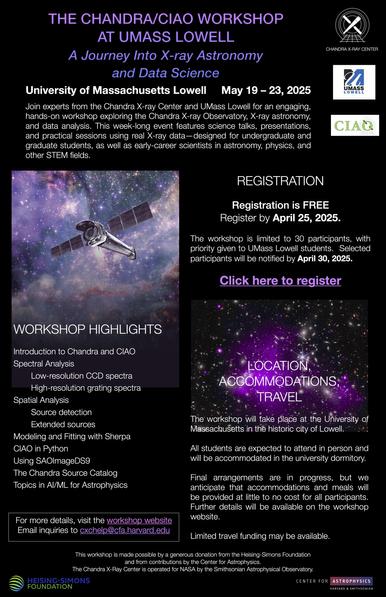The Chandra X-Ray Center is excited to announce the next Chandra/CIAO workshop to be held at UMass Lowell, 19-23 May, 2025. For more details and to register go to https://cxc.cfa.harvard.edu/ciao/workshop/may25/index.html
Chandra X-ray Center, operating NASA's flagship X-ray Observatory within the Smithsonian Astrophysical Observatory.
Privacy Terms: http://si.edu/Termsofuse
Time is running out! Abstracts are due in just over 24 hours for the #Chandra25 Symposium! To be held in Boston, MA this December, the Symposium will celebrate 25 years of Flagship X-ray science with one of NASA's Great Observatories. Further details, including abstract submission, can be found at https://cxc.harvard.edu/cdo/symposium_2024/
We hope to see many of you in Boston this December!
#Astronomy #Astrodon #XRaysAreTheBestRays #AstronomyConferences
This anniversary, we celebrate the team behind the mission. Thanks, Chandra team, for all you do!
(Shown here is a group shot of some of the team, past and present, at the party at our Control Center yesterday).
#Chandra25 #Astrodon #ChandraScience
@fe06 @hubble_space
You can see us here: https://3d.si.edu/collections/Chandra
#OTD in 1999, the Space Shuttle Columbia lifted off with the heaviest payload ever sent to orbit on the STS -- the #ChandraXRay Observatory. Soon after, Chandra was deployed from the Cargo Bay and boosted to its final orbit via the final Shuttle-based launch of the Inertial Upper Stage (IUS).
#Chandra25 #NASA #Astronomy #Astrophysics #Astrodon #OTD1999 #XRaysAreTheBestRays
Happy 25th launch-iversary to Hubble’s frequent partner in science, NASA’s #Chandra X-ray Observatory. 🚀 🎉
What a wild, wonderful quarter-century it’s been! Explore this collaborative image of the Bullet Cluster, key evidence for the existence of dark matter: https://bit.ly/4csUY82 #Chandra25
Good morning, it is July 23 here in Cambridge, MA, meaning that today is our 25th BIRTHDAY!
What better way to start this party than a release of 25 images to celebrate 25 years: https://www.nasa.gov/missions/chandra/25-images-to-celebrate-nasas-chandra-25th-anniversary/
#Astrodon #Astronomy #Astrophysics #NASA #Science #Space #XRayAstronomy #ChandraScience #XRaysAreTheBestRays #25Years
Hi everyone at #AAS244 -- swing by the Exhibitor Theater (in the Exhibit Hall, toward the back) at 10 AM today to hear @ThomasConnor talk about 25 Years of Science with NASA's Flagship X-ray Observatory.
At #AAS244 and looking for something to do? Come to our booth and learn about the ongoing science we're doing, our outreach initiatives, how to become an X-ray astronomer (or pretend to be one convincingly!), and grab some great swag!
New, on @TheConversationUS:
I'm an Astrophysicist mapping the Universe with data from #ChandraXRay: Clear, sharp photos help me study energetic black holes.
#NASA #Astrodon #Astrophysics #TheConversation #XraysAreTheBestRays #Science #Space #Astronomy
The second is "The Sounds of Feedback: Deep and Wide Imaging of the Cool Core of the Perseus Cluster" led by Andrew Fabian at the #UniversityOfCambridge
The Perseus cluster has a supermassive black hole in its center blowing giant bubbles. The image below, which is over 1 million light years across, shows these bubbles rising through the cluster's gas. Deeper Chandra observations will reveal how this energy propagates at the most massive of scales.
The first is "A Treasury Survey Probing the Baryon & Energy Cycle and X-ray Binary Evolution in Galaxies at High Angular Resolution", led by #OhioStateUniversity's Smita Mathur.
This survey will leverage our high-angular resolution capabilities in synergy with JWST, ALMA, VLT/MUSE, and others to observe the PHANGS galaxy sample, linking X-ray sources to their host stellar and nebular environments. M74, shown here, is a PHANGS galaxy already observed in this manner.
In November, we asked the community:
Are there major initiatives for which the capabilities of @ChandraScience are absolutely required to address fundamental questions about our current understanding of the Universe that would represent a crucial missed opportunity if they are not completed during Chandra's lifetime?
The community responded, and we are pleased to announce two Chandra Legacy Programs
https://cxc.harvard.edu/CLP/
That's No Moon!
Well, in this case it is. Back in 2003, #Saturn's moon Titan passed in front of the #CrabNebula. Chandra was on the spot, catching the transit as it happened. Astronomers were able to see the shadow cast by Titan, and used the size of that shadow to measure the extent of Titan's atmosphere.
A great result, demonstrating the power of the Dark Side!
More info: https://chandra.harvard.edu/press/04_releases/press_040504.html
Science: https://ui.adsabs.harvard.edu/abs/2004ApJ...607.1065M/abstract
#MayThe4th #StarWarsDay #Astrodon #ChandraXRay
We recently released version 2.1 of the #ChandraXRay Source Catalog!
In short, everything we observed that was released publicly prior to the end of 2021 has been reduced, processed, and made available for easy consumption. With over 400,000 individual sources and covering 730 square degrees, the CSC opens the X-ray sky to all astronomers -- even if you've never looked at an X-ray photon before.
Learn more:
https://chandra.si.edu/blog/node/879
#Astrodon #XRaysAreTheBestRays
Happy Earth Day! While the #ChandraXRay mission has observed sources near and far, we're one of a very limited set of astronomical observatories that has actively and intentionally observed Earth!
In the winter of 2003-2004, we observed the soft energy X-rays associated with the Northern Lights.
Learn more: https://chandra.cfa.harvard.edu/press/05_releases/press_122805.html
https://ui.adsabs.harvard.edu/abs/2007JASTP..69..179B/abstract
Credit: NASA/MSFC/CXC/A.Bhardwaj & R.Elsner, et al.; Earth model: NASA/GSFC/L.Perkins & G.Shirah
We're here at the Main Event of #HEAD21 -- The #Chandra25 Session. We have three talks---by Daryl Haggard, Tea Temim, and Stephanie LaMassa---on Sgr A*, Supernovae, and AGN, respectively. #ChandraScience
It's a full house at #HEAD21 to learn about the Chandra Source Catalog! CSC 2.1 just released last week, and you can access it at https://cxc.cfa.harvard.edu/csc/. #Astrodon #ChandraScience #XraysAreTheBestRays
Are you at #HEAD21? Come swing by our booth! Get a brand-new #Chandra25 sticker, find out about the upcoming symposium (https://cxc.cfa.harvard.edu/cdo/symposium_2024/), ask your questions about the observatory, and find out about the great new work being done by our archives and source catalog teams!
Roses are black
Violets are black
-- Hey, we only observe X-rays
Cut us some slack!
